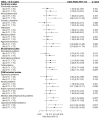Association of Prenatal Dietary Toxicants and Inorganic Arsenic Exposure with Children's Emotional and Behavioral Problems: ECLIPSES Study
- PMID: 38922078
- PMCID: PMC11209564
- DOI: 10.3390/toxics12060398
Association of Prenatal Dietary Toxicants and Inorganic Arsenic Exposure with Children's Emotional and Behavioral Problems: ECLIPSES Study
Abstract
Prenatal exposure to dietary toxicants is linked to neurocognitive issues, but its effect on early emotional and behavioral development in children is less clear. To explore the relationship between prenatal intake of As, iAs, Cd, MeHg, Pb, PCDD/Fs, DL-PCBs, and NDL-PCBs and emotional and behavioral issues in four-year-old children. This study included 192 mother-child pairs from the ECLIPSES study, assessing prenatal dietary toxicant exposure through a food-frequency questionnaire and Catalan Food Safety Agency data. Children's emotional and behavioral scores were evaluated using the Child Behavior Checklist for ages 1.5-5 years. Multivariable regression and logistic models were used, focusing on iAs after finding significant preliminary associations. Increased prenatal dietary intake of iAs was associated with internalizing, externalizing, and attention-deficit/hyperactivity problems. Higher iAs levels (>4.16 μg/day) significantly increased the risk of total problems (OR = 2.94) and specific issues like anxious/depressed (OR = 4.88), anxiety (OR = 3.27), and oppositional defiant problems (OR = 4.30). High iAs consumption correlated with the intake of meat, eggs, cereals, tubers, fruits, and pulses Prenatal dietary iAs exposure is associated with various emotional and behavioral problems in children. Monitoring and reducing iAs levels in food are crucial for public health.
Keywords: behavioral development; food; inorganic arsenic; neurodevelopment; prenatal dietary toxicants.
Conflict of interest statement
The authors declare no conflict of interest.
Figures
Similar articles
-
Dietary intake of metals, metalloids, and persistent organic pollutants in Spanish pregnant women. ECLIPSES study.Chemosphere. 2023 Dec;344:140319. doi: 10.1016/j.chemosphere.2023.140319. Epub 2023 Oct 4. Chemosphere. 2023. PMID: 37802481
-
Association between Prenatal Dietary Toxicants and Infant Neurodevelopment: The Role of Fish.Toxics. 2024 May 6;12(5):338. doi: 10.3390/toxics12050338. Toxics. 2024. PMID: 38787117 Free PMC article.
-
Inorganic arsenic exposure and neuropsychological development of children of 4-5 years of age living in Spain.Environ Res. 2019 Jul;174:135-142. doi: 10.1016/j.envres.2019.04.028. Epub 2019 Apr 29. Environ Res. 2019. PMID: 31075694 Free PMC article.
-
Exposure to Inorganic Arsenic and Lead and Autism Spectrum Disorder in Children: A Systematic Review and Meta-Analysis.Chem Res Toxicol. 2019 Oct 21;32(10):1904-1919. doi: 10.1021/acs.chemrestox.9b00134. Epub 2019 Oct 4. Chem Res Toxicol. 2019. PMID: 31549506
-
Biomarkers of exposure: a case study with inorganic arsenic.Environ Health Perspect. 2006 Nov;114(11):1790-6. doi: 10.1289/ehp.9058. Environ Health Perspect. 2006. PMID: 17107869 Free PMC article. Review.
References
-
- Gómez-Roig M.D., Pascal R., Cahuana M.J., García-Algar O., Sebastiani G., Andreu-Fernández V., Martínez L., Rodríguez G., Iglesia I., Ortiz-Arrabal O., et al. Environmental Exposure during Pregnancy: Influence on Prenatal Development and Early Life: A Comprehensive Review. Fetal Diagn. Ther. 2021;48:245–257. doi: 10.1159/000514884. - DOI - PubMed
-
- Molina-Mesa S., Martínez-Cendán J.P., Moyano-Rubiales D., Cubillas-Rodríguez I., Molina-García J., González-Mesa E. Detection of Relevant Heavy Metal Concentrations in Human Placental Tissue: Relationship between the Concentrations of Hg, As, Pb and Cd and the Diet of the Pregnant Woman. Int. J. Environ. Res. Public Health. 2022;19:14731. doi: 10.3390/ijerph192214731. - DOI - PMC - PubMed
-
- Caspersen I.H., Haugen M., Schjølberg S., Vejrup K., Knutsen H.K., Brantsæter A.L., Meltzer H.M., Alexander J., Magnus P., Kvalem H.E. Maternal Dietary Exposure to Dioxins and Polychlorinated Biphenyls (PCBs) Is Associated with Language Delay in 3year Old Norwegian Children. Environ. Int. 2016;91:180–187. doi: 10.1016/j.envint.2016.02.031. - DOI - PubMed
Grants and funding
LinkOut - more resources
Full Text Sources
Research Materials



